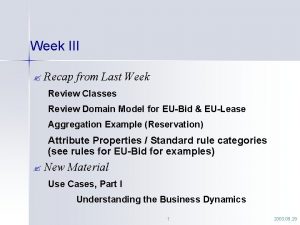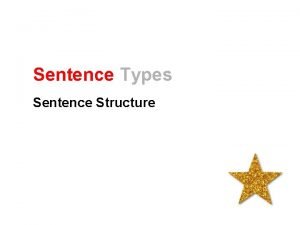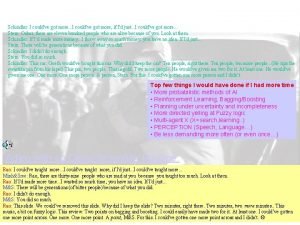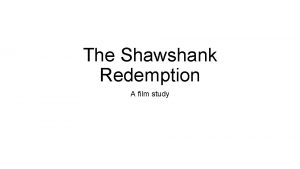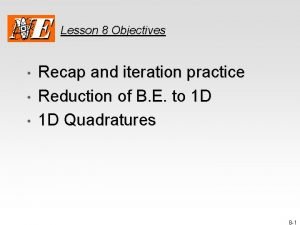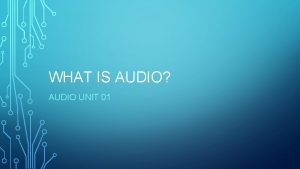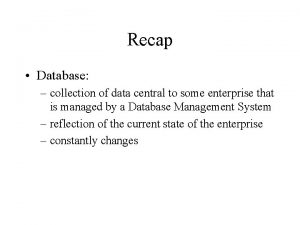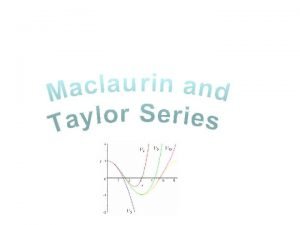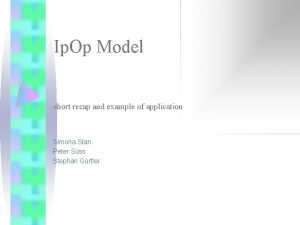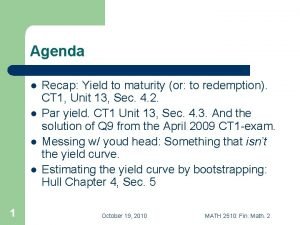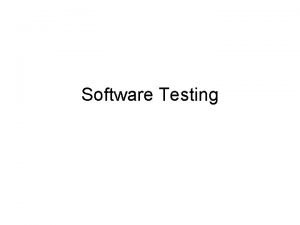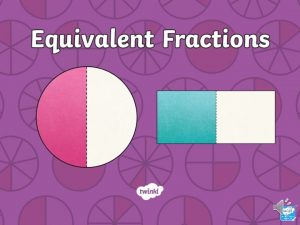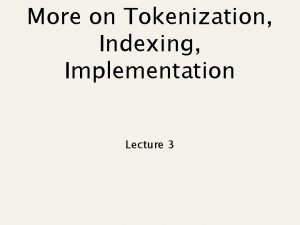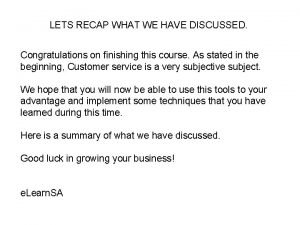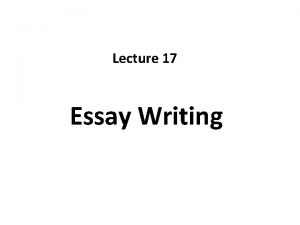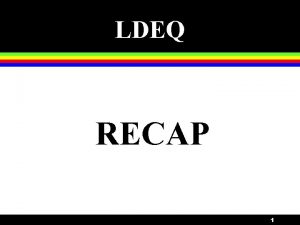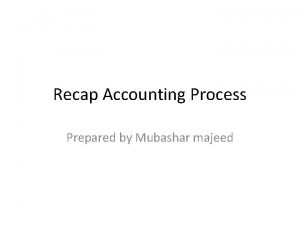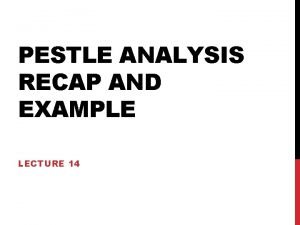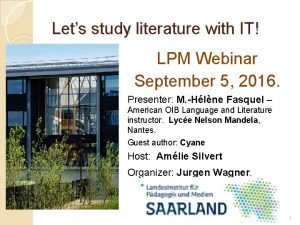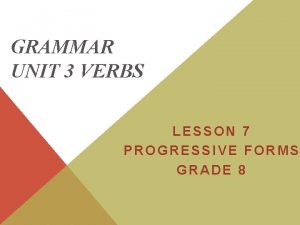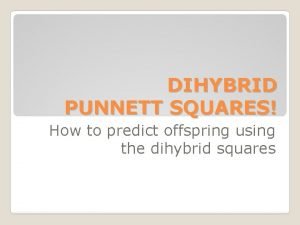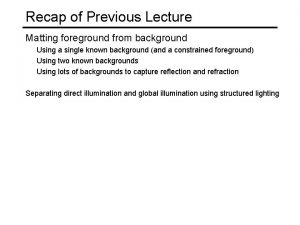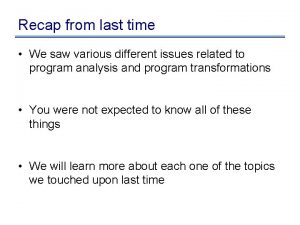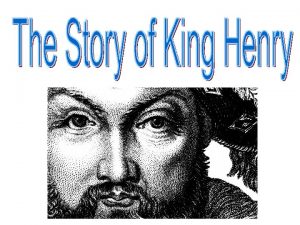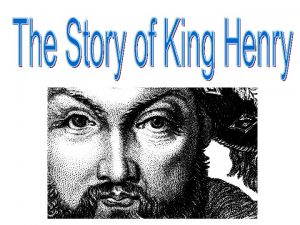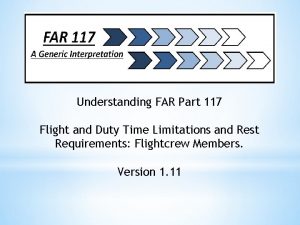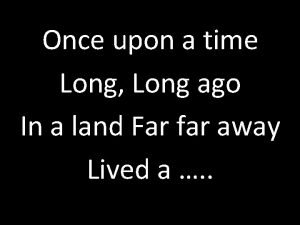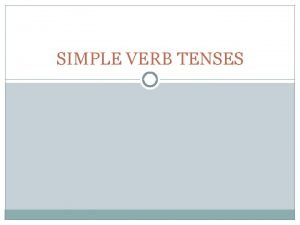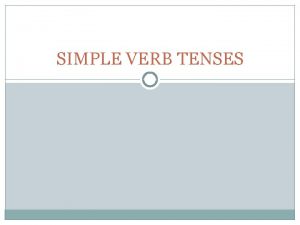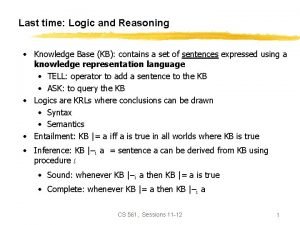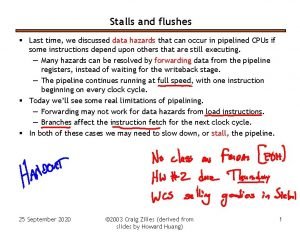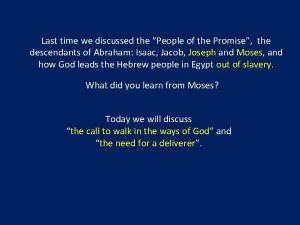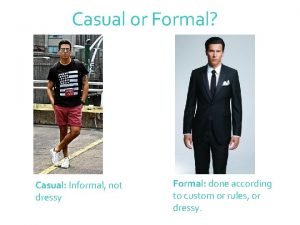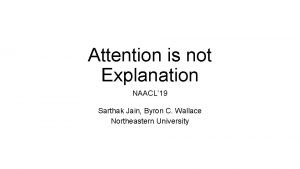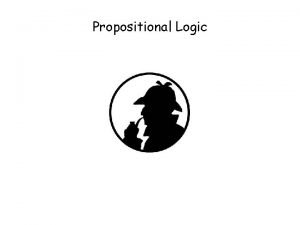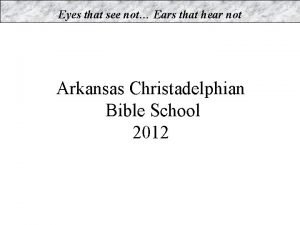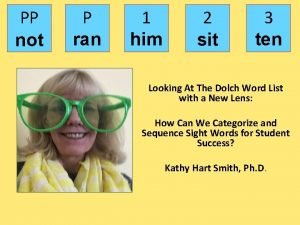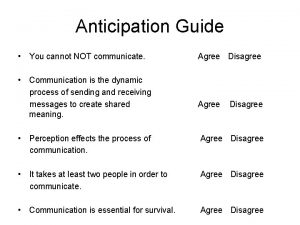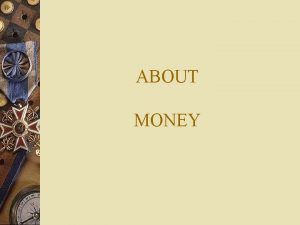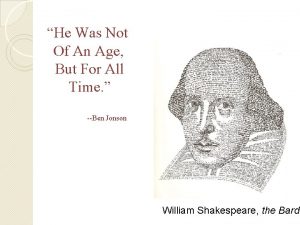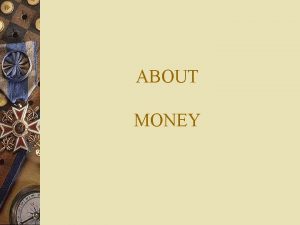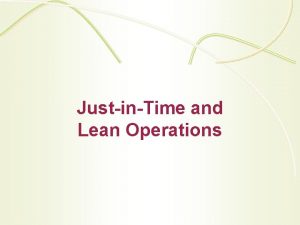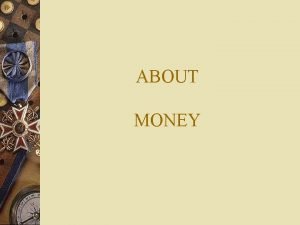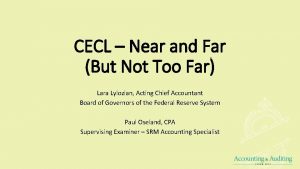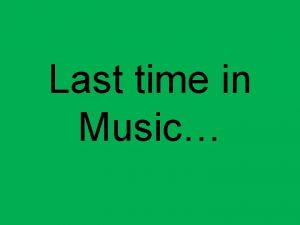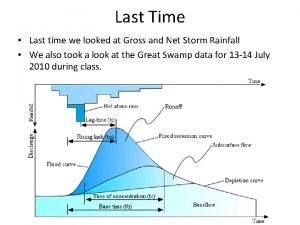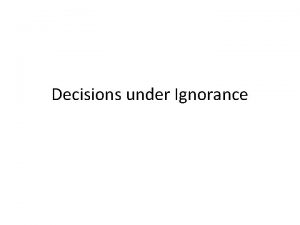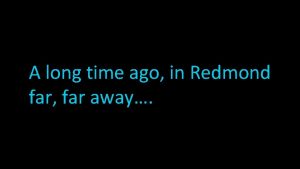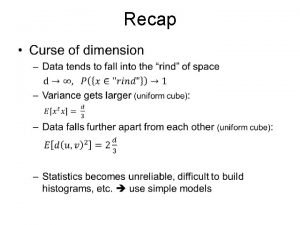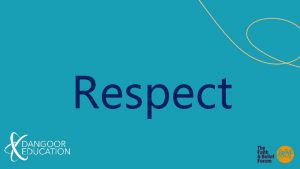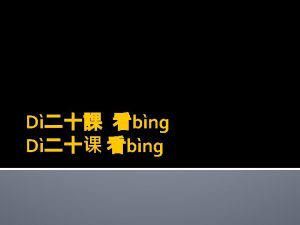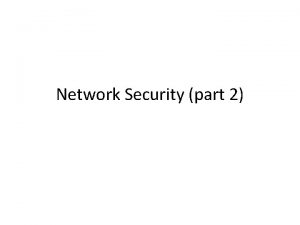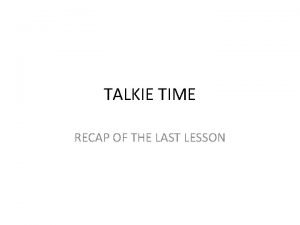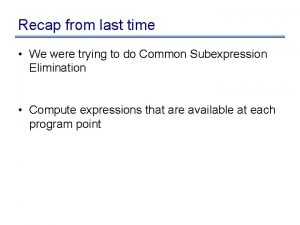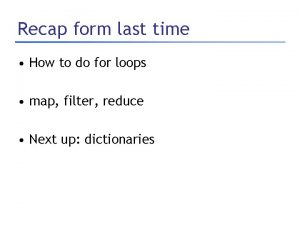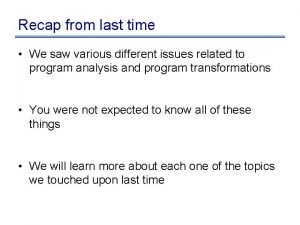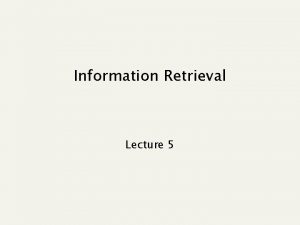Recap so far Not gotten to last time












































































- Slides: 76

Recap so far (Not gotten to last time) • So there were issues about the number of operands. – Recall that we have a fetch-execute cycle – first an instruction is retrieved from memory and then acted upon. – With unary instructions adding two numbers and storing the result required three instructions, that’s three fetches and three executions. – With ternary instructions it can be done with one instruction, one fetch and one execute. The execution is now more complicated but we have saved time on fetches. CSIT 301 (Blum) 1

Recap so far (Cont. ) • More operators means more complicated circuitry, the load and store aspects of the instruction would have to built into each separate instruction. • There is a speed versus complexity issue. And complexity also brings the issue of cost along with it. CSIT 301 (Blum) 2

Recap so far (Cont. ) • After determining the number of operands, came the issue of what the operands mean. – Are they data, addresses of data, or addresses of data? • Either we can decide to support all of these types of instructions (addressing modes) and choose complexity. Or we can choose to support only some of them and sacrifice efficiency. – You can eliminate Add Immediate if you always store the values you want to add. CSIT 301 (Blum) 3

Data Types • Apart from addressing, another issue is the type of data the operation is acting on. – The process for adding integers is different from the process for adding floating point numbers. – So one may have separate ADD and FADD for the addition of integers and floats respectively. – Furthermore, one may need to add instructions to convert from one type to another. • To add an integer to a float, convert the integer to a float and then add the floats. CSIT 301 (Blum) 4

Binary Numbers Material on Data Representation can be found in Chapter 2 of Computer Architecture (Nicholas Carter) CSIT 301 (Blum) 5

Why Binary? • Maximal distinction among values minimal corruption from noise. • Imagine taking the same physical attribute of a circuit, e. g. a voltage lying between 0 and 5 volts, to represent a number. • The overall range can be divided into any number of regions. CSIT 301 (Blum) 6

Don’t sweat the small stuff • For decimal numbers, fluctuations must be less than 0. 25 volts. • For binary numbers, fluctuations must be less than 1. 25 volts Decimal CSIT 301 (Blum) Binary 0 volts 7

Range actually split in three High Forbidden range Low CSIT 301 (Blum) 8

It doesn’t matter …. • Two of the standard voltages coming from a computer’s power supply are ideally supposed to be 5. 00 volts and 12. 00 volts • Measurements often reveal values that are slightly off – e. g. 5. 14 volts or 12. 22 volts or some such value. • So what, who cares. CSIT 301 (Blum) 9

How to represent big integers • Use positional weighting, same as with decimal numbers • 205 = 2 102 + 0 101 + 5 100 • 11001101 = 1 27 + 1 26 + 0 25 + 0 24 + 1 23 + 1 22 + 0 21 + 1 20 = 128 + 64 + 8 + 4 + 1 = 205 CSIT 301 (Blum) 10

Converting 205 to Binary • 205/2 = 102 with a remainder of 1, place the 1 in the least significant digit position 1 • Repeat 102/2 = 51, remainder 0 0 CSIT 301 (Blum) 1 11

Iterate • 51/2 = 25, remainder 1 1 0 1 • 25/2 = 12, remainder 1 1 • 12/2 = 6, remainder 0 0 CSIT 301 (Blum) 1 12

Iterate • 6/2 = 3, remainder 0 0 0 1 1 1 0 1 • 3/2 = 1, remainder 1 1 0 0 • 1/2 = 0, remainder 1 1 CSIT 301 (Blum) 1 0 0 13

Recap 1 1 0 0 1 1 27 + 1 26 + 0 25 + 0 24 + 1 23 + 1 22 + 0 21 + 1 20 205 CSIT 301 (Blum) 14

Finite representation • Typically we just think computers do binary math. • But an important distinction between binary math in the abstract and what computers do is that computers are finite. • There are only so many flip-flops or logic gates in the computer. • When we declare a variable, we set aside a certain number of flip-flops (bits of memory) to hold the value of the variable. And this limits the values the variable can have. CSIT 301 (Blum) 15

Same number, different representation • • • 5 using 8 bits 0000 0101 5 using 16 bits 0000 0101 5 using 32 bits 0000 0000 0101 CSIT 301 (Blum) 16

Adding Binary Numbers • Same as decimal; if the sum of digits in a given position exceeds the base (10 for decimal, 2 for binary) then there is a carry into the next higher position + CSIT 301 (Blum) 1 3 3 7 9 5 4 17

Adding Binary Numbers 1 carries + CSIT 301 (Blum) 1 1 1 0 0 1 1 1 39 0 1 0 0 0 1 1 35 1 0 0 1 0 74 18

Uh oh, overflow • What if you use a byte (8 bits) to represent an integer 1 1 1 0 0 204 0 1 1 1 0 118 ? ? ? 1 0 170 • A byte may not be enough to represent the sum of two such numbers. CSIT 301 (Blum) 19

Biggest * unsigned integers 4 bit: 1111 15 = 24 - 1 8 bit: 1111 255 = 28 – 1 16 bit: 11111111 65535= 216 – 1 32 bit: 1111111111111111 4294967295= 232 – 1 • Etc. *If one uses all of the bits available to represent only positive counting numbers, one is said to be working with unsigned integers. • • CSIT 301 (Blum) 20

Bigger Numbers • High-level languages often offer a hierarchy of types that differ in the number of bits used. • You can represent larger numbers than allowed by the highest type in the hierarchy by using more words. • You just have to keep track of the overflows to know how the lower numbers (less significant words) are affecting the larger numbers (more significant words). CSIT 301 (Blum) 21

Negative numbers • Negative x is the number that when added to x gives zero 1 1 1 0 1 0 x 1 1 0 -x 0 0 0 0 • Ignoring overflow the two eight-bit numbers above add up to zero CSIT 301 (Blum) 22

Two’s Complement: a two-step procedure for finding -x from x 0 0 1 0 1 0 0 1 x • Step 1: exchange 1’s and 0’s 1 1 0 1 • Step 2: add 1 (to the lowest bit only) 1 CSIT 301 (Blum) 1 0 1 1 0 -x 23

Sign bit • With the two’s complement approach, all positive numbers start with a 0 in the leftmost, most-significant bit and all negative numbers start with 1. • So the first bit is called the sign bit. • But note you have to work harder than just strip away the first bit. • 10000001 IS NOT the 8 -bit version of – 1 CSIT 301 (Blum) 24

Add 1’s to the left to get the same negative number using more bits • • -5 using 8 bits 11111011 -5 using 16 bits 1111111011 -5 using 32 bits 111111111111111011 When the numbers represented are whole numbers (positive or negative), they are called integers. CSIT 301 (Blum) 25

3 -bit signed and unsigned 7 6 5 4 3 2 1 0 1 1 0 0 CSIT 301 (Blum) 1 1 0 0 1 0 1 0 3 2 1 0 -1 -2 -3 -4 0 0 1 1 1 0 0 1 0 1 0 Think of driving a brand new car in reverse. What would happen to the odometer? 26

Biggest signed integers 4 bit: 0111 7 = 23 - 1 8 bit: 01111111 127 = 27 – 1 16 bit: 011111111 32767= 215 – 1 32 bit: 01111111111111111 2147483647= 231 – 1 • Etc. • • CSIT 301 (Blum) 27

Most negative signed integers 4 bit: 1000 -8 = - 23 8 bit: 10000000 - 128 = - 27 16 bit: 100000000 -32768= - 215 32 bit: 10000000000000000 -2147483648= - 231 • Etc. • • CSIT 301 (Blum) 28

Riddle 1 • • • 1 0 1 1 0 Is it 214? Or is it – 42? Or is it Ö? Or is it …? It’s a matter of interpretation – How was it declared? CSIT 301 (Blum) 29

Hexadecimal Numbers • Even moderately sized decimal numbers end up as long strings in binary. • Hexadecimal numbers (base 16) are often used because the strings are shorter and the conversion to binary is easier. • There are 16 digits: 0 -9 and A-F. CSIT 301 (Blum) 30

Decimal Binary Hex • • 0 0000 0 1 0001 1 2 0010 2 3 0011 3 4 0100 4 5 0101 5 6 0110 6 7 0111 7 CSIT 301 (Blum) • • 8 1000 8 9 1001 9 10 1010 A 11 1011 B 12 1100 C 13 1101 D 14 1110 E 15 1111 F 31

Binary to Hex • Break a binary string into groups of four bits (nibbles). • Convert each nibble separately. 1 1 1 0 0 1 E CSIT 301 (Blum) C 9 32

Numbers from Logic • All of the numerical operations we have talked about are really just combinations of logical operations. • E. g. the adding operation is just a particular combination of logic operations • Possibilities for adding two bits – – 0+0=0 (with no carry) 0+1=1 (with no carry) 1+0=1 (with no carry) 1+1=0 (with a carry) CSIT 301 (Blum) 33

Addition Truth Table INPUT OUTPUT Sum Carry A XOR B A AND B A B 0 0 0 1 1 0 1 0 1 CSIT 301 (Blum) 34

Multiplication: Shift and add + CSIT 301 (Blum) 1 1 0 0 0 1 1 1 0 0 0 0 0 1 1 1 1 shift 0 1 1 35

Fractions • Similar to what we’re used to with decimal numbers 3. 14159 = 3 · 100 + 1 · 10 -1 + 4 · 10 -2 + 1 · 10 -3 + 5 · 10 -4 + 9 · 10 -5 11. 001001 = 1 · 21 + 1 · 20 + 0 · 2 -1 + 0 · 2 -2 + 1 · 2 -3 + 0 · 2 -4 + 0 · 2 -5 + 1 · 2 -6 (11. 001001 3. 140625) CSIT 301 (Blum) 36

Converting decimal to binary II • 98. 61 – Integer part • • 98 / 2 49 / 2 24 / 2 12 / 2 6/2 3/2 1/2 = 49 = 24 = 12 = 6 = 3 = 1 = 0 remainder remainder 0 1 0 0 0 1 1 – 1100010 CSIT 301 (Blum) 37

Converting decimal to binary III • 98. 61 – Fractional part • • • 0. 61 2 = 1. 22 0. 22 2 = 0. 44 2 = 0. 88 2 = 1. 76 0. 76 2 = 1. 52 0. 52 2 = 1. 04 –. 100111 CSIT 301 (Blum) 38

Another Example (Whole number part) • 123. 456 – Integer part • • 123 / 2 = 61 remainder 1 61 / 2 = 30 remainder 1 30 / 2 = 15 remainder 0 15 / 2 = 7 remainder 1 7 / 2 = 3 remainder 1 3 / 2 = 1 remainder 1 1 / 2 = 0 remainder 1 – 1111011 CSIT 301 (Blum) 39

Checking: Go to Programs/Accessories/Calculator CSIT 301 (Blum) 40

Put the calculator in Scientific view CSIT 301 (Blum) 41

Enter number while in decimal mode, then put Calculator into binary mode CSIT 301 (Blum) 42

Another Example (fractional part) • 123. 456 – Fractional part • • 0. 456 2 = 0. 912 2 = 1. 824 0. 824 2 = 1. 648 0. 648 2 = 1. 296 0. 296 2 = 0. 592 2 = 1. 184 0. 184 2 = 0. 368 … –. 0111010… CSIT 301 (Blum) 43

Checking fractional part: Enter digits found in binary mode Note that the leading zero does not display. CSIT 301 (Blum) 44

Convert to decimal mode, then CSIT 301 (Blum) 45

Divide by 2 raised to the number of digits (in this case 7, including leading zero) 1 2 3 4 CSIT 301 (Blum) 46

In most cases it will not be exact CSIT 301 (Blum) 47

Other way around • Multiply fraction by 2 raised to the desired number of digits in the fractional part. For example –. 456 27 = 58. 368 • Throw away the fractional part and represent the whole number – 58 111010 • But note that we specified 7 digits and the result above uses only 6. Therefore we need to put in the leading 0 – 0111010 CSIT 301 (Blum) 48

Fixed point • If one has a set number of bits reserved for representing the whole number part and another set number of bits reserved for representing the fractional part of a number, then one is said to be using fixed point representation. – The point dividing whole number from fraction has an unchanging (fixed) place in the number. CSIT 301 (Blum) 49

Limits of the fixed point approach • Suppose you use 4 bits for the whole number part and 4 bits for the fractional part (ignoring sign for now). • The largest number would be 1111 = 15. 9375 • The smallest, non-zero number would be 0000. 0001 =. 0625 CSIT 301 (Blum) 50

Floating point representation • Floating point representation allows one to represent a wider range of numbers using the same number of bits. • It is like scientific notation. CSIT 301 (Blum) 51

Scientific notation • Used to represent very large and very small numbers. – Ex. Avogadro’s number • 6. 0221367 1023 particles • 6022136700000000 – Ex. Fundamental charge e • 1. 60217733 10 -19 C • 0. 000000000160217733 C CSIT 301 (Blum) 52

Scientific notation: all of these are the same number • • • 12345. 6789 = 1234. 56789 100 1234. 56789 10 = 1234. 56789 101 123. 456789 100 =123. 456789 102 12. 3456789 103 1. 23456789 104 Rule: Shift the point to the left and increment the power of ten. CSIT 301 (Blum) 53

Small numbers • • 0. 000001234 0. 00001234 10 -1 0. 0001234 10 -2 0. 001234 10 -3 0. 01234 10 -4 0. 1234 10 -5 1. 234 10 -6 Rule: shift point to the right and decrement the power. CSIT 301 (Blum) 54

Floating Point Rules • We’ll use a set of rules that are close but not quite the same as the IEEE 754 standards for floating point representation. • Starting with the fixed point binary representation, shift the point and increase the power (of 2 now that we’re in binary). • Shift so that the number has no whole number part and also so that the first fractional bit (the half’s place) has a 1. CSIT 301 (Blum) 55

Floats • SHIFT expression so it is just under 1 and keep track of the number of shifts • 1100010. 10011001 • . 110001010011001 27 • Express the number of shifts in binary • . 110001010011001 200000111 CSIT 301 (Blum) We’re not done yet so this exponent will change. 56

Mantissa and Exponent and Sign • • • . 110001010011001 200000111 (Significand) Mantissa. 110001010011001 200000111 Exponent The number may be negative, so there a bit (the sign bit) reserved to indicate whether the number is positive or negative CSIT 301 (Blum) 57

Small numbers • 0. 000010101110 • 0. 10101110 2 -4 • The power (a. k. a. the exponent) could be negative so we have to be able to deal with that. • Floating point numbers use a procedure known as biasing to handle the negative exponent problem. CSIT 301 (Blum) 58

Biasing • Actually the exponent is not represented as shown on the previously. • There were 8 bits used to represent the exponent on the previous slide, that means there are 256 numbers that could be represented. • Since the exponent could be negative (to represent numbers less than 1), we choose half of the range to be positive and half to be negative , i. e. -128 to 127. CSIT 301 (Blum) 59

Biasing (Cont. ) • In biasing, one does not use 2’s complement or a sign bit. • Instead one adds a bias (equal to the magnitude of the most negative number) to the exponents and represents the result of that addition. CSIT 301 (Blum) 60

Biasing (Cont. ) • With 8 bits, the bias is 128 (= 27 that is 2 raised to the number of bits used for the exponent minus one). • In our previous example, we had to shift 7 times to the left, corresponding to an exponent of +7. • We add that shift to the bias 128+7=135. • That is the number we put in the exponent portion: 135 10000111. CSIT 301 (Blum) 61

Big floats • Assume we use 8 bits, 4 for the mantissa and 4 for the exponent (neglecting sign). What is the largest float? • Mantissa: 1111 Exponent 1111 • 0. 9375 27 • =120 • (Compare this to the largest fixed-point number using the same amount of space 15. 9375) CSIT 301 (Blum) 62

Small floats • Assume we use 8 bits, 4 for the mantissa and 4 for the exponent (neglecting sign). What is the smallest float? • Mantissa: 1000 Exponent 0000 • 0. 5 2 -8 • = 0. 001953125 • (Compare this to the smallest fixed-point number using the same amount of space. 0625) CSIT 301 (Blum) 63

Adding Floats • Consider adding the following numbers expressed in scientific notation 3. 456789 103 1. 212121 10 -2 • The first step is to re-express the number with the smaller magnitude so that it has the same exponent as the other number. CSIT 301 (Blum) 64

Adding Floats (Cont. ) • • 1. 212121 10 -2 0. 1212121 10 -1 0. 01212121 100 0. 001212121 101 0. 0001212121 102 0. 00001212121 103 The number was shifted 5 times (3 -(-2)). CSIT 301 (Blum) 65

Adding Floats (Cont. ) • When the exponents are equal the mantissas can be added. 3. 456789 103 0. 00001212121 103 • =3. 45680112121 103 CSIT 301 (Blum) 66

Rounding • In a computer there a finite number of bits used to represent a number. • When the smaller floating-point number is shifted to make the exponents equal, some of the less significant bits are lost. • This loss of information (precision) is known as rounding. CSIT 301 (Blum) 67

One more fine point about floating-point representation • As discussed so far, the mantissa (significand) always starts with a 1. • When storage was expensive, designers opted not to represent this bit, since it is always 1. • It had to be inserted for various operations on the number (adding, multiplying, etc. ), but it did not have to be stored. CSIT 301 (Blum) 68

Still another fine point • When we assume that the mantissa must start with a 1, we lose 0. • Zero is too important a number to lose, so we interpret the mantissa of all zeros and exponent of all zeros as zero – Even though ordinarily we would assume the mantissa started with a one that we didn’t store. CSIT 301 (Blum) 69

Yet another fine point • In the IEEE 754 format for floats, you bias by one less (127) and reserve the exponents 0000 and 1111 for special purposes. • One of these special purposes is “Not a number” (Na. N) which is the floating point version of overflow. CSIT 301 (Blum) 70

An example • Represent -9087. 8735 as a float using 23 bits for the mantissa, 8 for the exponent and one for the sign. • Convert the whole number magnitude 9087 to binary: 10 0011 0111 1111 • That uses up 14 of the 23 bits for the mantissa, leaving 9 for the fractional part. CSIT 301 (Blum) 71

An example (Cont. ) • Multiply the fractional part by 29 and convert whole number part of that to binary, make sure in uses 9 bits (add leading 0’s if it doesn’t). • . 8735 29 = 447. 232 • 447 110111111 CSIT 301 (Blum) 72

An example (Cont. ) • • • 10001101111111. 110111111. 1000110111110111111 214 Mantissa 1000110111110111111 Exponent 14+128=142 10001110 Sign bit 1 (because number was negative) CSIT 301 (Blum) 73

Example 2 • 0. 0076534 • No whole number part. Begin by using all 23 mantissa bits for the fractional part. • 0. 0076534 223 = 64201. 3724672 • 64201 1111101011001001 • Only uses 16 places, means that so far number starts with 7 zeros. But float mantissas are supposed to start with 1. CSIT 301 (Blum) 74

Example 2 (Cont. ) 23+7 • • • 0. 0076534 230 = 8217775. 6758016 821775 11111010110010010101111 Above is mantissa Exponent 128 – 7 = 121 01111001 Sign bit 0 (positive number) CSIT 301 (Blum) 75

References • Computer Architecture, Nicholas Carter • Computer Systems: Organization and Architecture, John Carpinelli CSIT 301 (Blum) 76
 Recap from last week
Recap from last week Figure of speech in paper seeming boy
Figure of speech in paper seeming boy Gusty waves indicate
Gusty waves indicate In a kingdom far far away
In a kingdom far far away Far far away city
Far far away city Forced sterilization
Forced sterilization Circle the cause and underline the effect
Circle the cause and underline the effect The weather has been nice but it may snow again any day
The weather has been nice but it may snow again any day Couldve gotten
Couldve gotten Sadlier unit 1 level d synonyms
Sadlier unit 1 level d synonyms The shawshank redemption analysis
The shawshank redemption analysis Chapter 8 and 9 great gatsby summary
Chapter 8 and 9 great gatsby summary Price is right recap
Price is right recap What is the purpose of an iteration recap?
What is the purpose of an iteration recap? Recap intensity clipping
Recap intensity clipping 60 minutes recap
60 minutes recap Recap database
Recap database Bracket power rule
Bracket power rule Sample script for recapitulation
Sample script for recapitulation Recap introduction
Recap introduction The crucible act 2 discussion questions
The crucible act 2 discussion questions Pontius pilate the crucible
Pontius pilate the crucible Logbook recap example
Logbook recap example Ytm recap
Ytm recap Black box recap
Black box recap Fractions recap
Fractions recap Recap
Recap Horizontal axis is called
Horizontal axis is called Recap indexing scans
Recap indexing scans Lets have a recap
Lets have a recap Recap poster
Recap poster What is an essay
What is an essay Ldeq recap
Ldeq recap Key points of romeo and juliet
Key points of romeo and juliet Recap accounting
Recap accounting What is economic environment example
What is economic environment example Let's recap
Let's recap Let's recap
Let's recap How to foil in biology
How to foil in biology Recap background
Recap background Normative ethics
Normative ethics Saw recap
Saw recap Briefly recap
Briefly recap Once in a faraway city
Once in a faraway city King henry died drinking chocolate milk
King henry died drinking chocolate milk Far 117 minimum rest
Far 117 minimum rest Once upon a time a long long time ago
Once upon a time a long long time ago Once upon a time long ago and far away
Once upon a time long ago and far away 30 of the best far side cartoons of all time
30 of the best far side cartoons of all time Once apon a time in venice
Once apon a time in venice For minutes. start.
For minutes. start. Simple present tense of verb
Simple present tense of verb Blank until you finish your homework
Blank until you finish your homework Alex did not _____ last weekend.
Alex did not _____ last weekend. For the last time sentence
For the last time sentence Stalls
Stalls Last time we discussed
Last time we discussed If you're not confused you're not paying attention
If you're not confused you're not paying attention Casual informal style
Casual informal style Attention is not not explanation
Attention is not not explanation Not too broad and not too narrow
Not too broad and not too narrow If not p then not q
If not p then not q Not too big not too small just right
Not too big not too small just right Love is not all imagery
Love is not all imagery Eyes that see and ears that hear
Eyes that see and ears that hear Pp not not
Pp not not If you can't measure it it does not exist
If you can't measure it it does not exist We will not be moved when everything around is shaking
We will not be moved when everything around is shaking Not a rustling leaf not a bird
Not a rustling leaf not a bird You cannot not communicate
You cannot not communicate Third conditional past perfect continuous
Third conditional past perfect continuous Money can buy a clock but not time
Money can buy a clock but not time Not of an age, but for all time
Not of an age, but for all time With money you can buy clock not time
With money you can buy clock not time You may delay but time will not benjamin franklin
You may delay but time will not benjamin franklin Jit scheduling tactics
Jit scheduling tactics You can buy a clock but not time
You can buy a clock but not time
